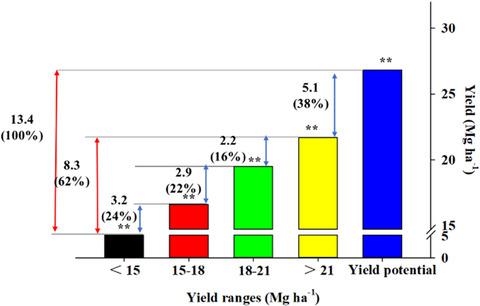当前位置:
X-MOL 学术
›
Food Energy Secur.
›
论文详情
Our official English website, www.x-mol.net, welcomes your feedback! (Note: you will need to create a separate account there.)
Improving the yield potential in maize by constructing the ideal plant type and optimizing the maize canopy structure
Food and Energy Security ( IF 5 ) Pub Date : 2021-07-13 , DOI: 10.1002/fes3.312 Rongfa Li 1, 2 , Guoqiang Zhang 2 , Guangzhou Liu 2 , Keru Wang 2 , Ruizhi Xie 2 , Peng Hou 2 , Bo Ming 2 , Zhigang Wang 1 , Shaokun Li 2
Food and Energy Security ( IF 5 ) Pub Date : 2021-07-13 , DOI: 10.1002/fes3.312 Rongfa Li 1, 2 , Guoqiang Zhang 2 , Guangzhou Liu 2 , Keru Wang 2 , Ruizhi Xie 2 , Peng Hou 2 , Bo Ming 2 , Zhigang Wang 1 , Shaokun Li 2
Affiliation

|
Understanding the impact of changes in the crop canopy on yield is important in order to meet future food demands. We designed a field experiment to investigate the relationships between crop-related factors and yield gaps in maize to enhance crop yields from 2010 to 2018 in Qitai, China. Maize grain yields (n = 247) were divided into four yield ranges: <15 Mg ha−1 (n = 30), 15–18 Mg ha−1 (n = 79), 18–21 Mg ha−1 (n = 114), and >21 Mg ha−1 (n = 24). The characteristics of the maize canopy structure as well as the light interception, photosynthetic potential, and radiation utilization efficiency in these four yield ranges were analyzed. The canopy structure of treated fields with yields >21 Mg ha−1 had a higher leaf area index (7.2), lower ear ratio (0.39), longer internodes above the ear (20.1 cm), larger leaf orientation value (LOV) above the ear (48.6), smaller leaf angle above the ear (18°), and smaller LOV below the ear (36.0) when compared to the other treatments. These findings suggested that the yield gap is dependent on canopy structure, and the evolutionary trend also accounted for significant increases in post-LAD (p < 0.01), changes in crop growth rate (CGR; p < 0.01), net assimilation rate (NAR; p < 0.05), and radiation utilization efficiency. The radiation utilization efficiencies in the 15–18, 18–21, and >21 Mg ha−1 treatments (1.23, 1.28, and 1.38 g MJ−1, respectively) were higher than for the <15 Mg ha−1 treatment (1.10 g MJ−1). Furthermore, there are opportunities to narrow the yield gaps by optimizing the canopy structure to make full use of the solar radiation resources. Our results will help breeders choose an ideal canopy structure to improve yield. In addition, our results may serve as a general guide for other maize growing regions.
更新日期:2021-07-13


























 京公网安备 11010802027423号
京公网安备 11010802027423号